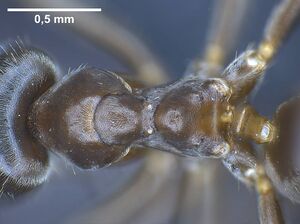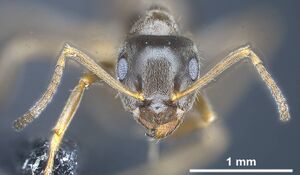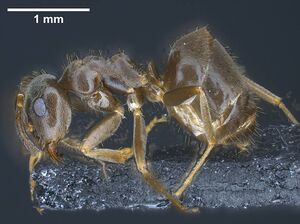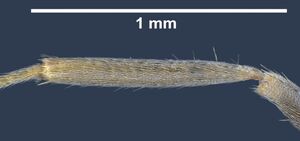Lasius casevitzi
| Lasius casevitzi | |
|---|---|

| |
| Scientific classification | |
| Kingdom: | Animalia |
| Phylum: | Arthropoda |
| Class: | Insecta |
| Order: | Hymenoptera |
| Family: | Formicidae |
| Subfamily: | Formicinae |
| Tribe: | Lasiini |
| Genus: | Lasius |
| Section: | niger clade |
| Species group: | alienus |
| Species complex: | paralienus |
| Species: | L. casevitzi |
| Binomial name | |
| Lasius casevitzi Seifert & Galkowski, 2016 | |
This species is endemic to Corsica where it is a common species. It does not occur in xerothermous grassland unlike other members of the L. paralienus complex and prefers semi-arboreal habitats and dry open forest. Nests are in soil, under trees or under stones. It is absent from the coastal environment and from elevations above 1100 m. The altitudinal extremes within 50 records were 23 m and 1100 m, with the majority of nests found between 300 m and 800 m. Alates were not observed in the nests during collecting in July and August. The ants behave aggressively during disturbance of the nest by the collector.
Identification
Seifert and Galkowski (2016) - Palaearctic Lasius s. str. species belonging to the Lasius paralienus species complex. The species in this complex are separable from related species by the combination of low clypeal pubescence distance, low setae numbers on scape and differences in length of maxillary palp segments. Lasius alienus, Lasius psammophilus and Lasius piliferus are the most similar species occurring within the geographic range of the three L. paralienus complex species. L. alienus differs from the other five species by having strongly reduced setae numbers on the metapleuron below the level of the propodeal spiracle. A safe separation of individual workers is possible by a discriminant function considering head width, the length of the terminal maxillary palp segment and clypeal pubescence distance.
Keys including this Species
- Key to Europe and Asia Minor Lasius alienus group species
- Key to Palaearctic Lasius s. str.
- Key to Palaearctic Lasius subgenus Lasius s. st.
Distribution
L. casevitzi is clearly a Corsican endemic. Due to its comparably strong isolation, this Mediterranean island has many endemic insect species with rather strongly deviating characters. Among ants these are Temnothorax melas, Temnothorax corsicus, Formica corsica and Plagiolepis delaugerrei.
Latitudinal Distribution Pattern
Latitudinal Range: 42.487° to 41.697°.
| North Temperate |
North Subtropical |
Tropical | South Subtropical |
South Temperate |
- Source: AntMaps
Distribution based on Regional Taxon Lists
Palaearctic Region: France (type locality), Italy.
Distribution based on AntMaps
Distribution based on AntWeb specimens
Check data from AntWeb
Countries Occupied
| Number of countries occupied by this species based on AntWiki Regional Taxon Lists. In general, fewer countries occupied indicates a narrower range, while more countries indicates a more widespread species. |

|
Estimated Abundance
| Relative abundance based on number of AntMaps records per species (this species within the purple bar). Fewer records (to the left) indicates a less abundant/encountered species while more records (to the right) indicates more abundant/encountered species. |

|
Biology
Castes
Worker
Images from AntWeb
         
| |
| Specimen code casevitzi. . | |
Nomenclature
The following information is derived from Barry Bolton's Online Catalogue of the Ants of the World.
- casevitzi. Lasius casevitzi Seifert & Galkowski, 2016: 54, figs. 6-9 (w.) FRANCE (CORSICA).
Unless otherwise noted the text for the remainder of this section is reported from the publication that includes the original description.
Description
Worker
Numeric data given in the following description are primary data (without removal of allometric variance) of 18 measured individuals.
Rather small-sized, CS 849 ± 41 [779,912] μm. Basic morphology not different from other members of the Lasius alienus group. Head moderately elongated, with convex sides and straight posterior margin of vertex, CL/ CW 1.078 ± 0.019 [1.039,1.123]. Scape rather long, SL/CS 1.006 ± 0.016 [0.981,1.036]. Eye medium-sized and moderately distant from posterior margin of head, EYE/CS 0.242 ± 0.004 [0.236,0.248], PoOc/CL 0.247 ± 0.005 [0.239,0.254]. Antennal socket situated rather close to posterior clypeal margin, dCLAn/CS 4.43 ± 0.26 [4.06,4.97]%. Masticatory border of mandibles with 8-9 teeth. Maxillary palps with six segments and much longer than in related species, MP6/CS 0.214 ± 0.009 [0.201,0.235]. Pubescence on whole body surfaces dense and whitish, sqPDCL 3.35 ±0.20 [3.00,3.72]. Mean length of pubescence hairs between frontal carinae 36.9 ± 2.23 [32.9,40.5] μm. Pilosity compared to next related species rather rich and long—in particular on genae and tibiae. Eyes with several microsetae of 11-16 μm length. Scape with no or very few standing setae: nSc 1.20 ± 0.89 [0.0,3.0]. Genae and extensor profile of hind tibia with more erect setae than in the next related species: nGen 3.86 ± 0.71 [2.5,5.0], nHT 7.85 ± 1.73 [5.5,12.5]. Underside of head and hind margin of vertex with rather numerous standing setae: nGu 3.69 ± 0.94 [2.0,6.0], nOcc 11.90 ± 1.83 [9.5,15.5]. Metapleuron below level of propodeal stigma with rather many erect to suberect setae: nSt 4.72 ± 0.87 [3.0,6.0]. Length of setae on pronotum rather large: PnHL/CS 0.157 ± 0.018 [0.107,0.175]. Whole body concolorous medium to dark brown; mandibles, scape and sometimes tibia lighter reddish or yellowish brown. Mesosoma in lateral view with an angulate-convex propodeal dome. Petiole scale low, in frontal view with slightly convex sides converging towards the dorsal crest which is straight or slightly convex.
Type Material
- Holotype, worker, Corse: Bonifatu, 687m, France, 42°26′24″N 8°52′05″E / 42.440°N 8.868°E, 12 July 2015, Galkowski, Muséum National d’Histoire Naturelle Paris.
- Three paratype workers with same site labeling as the holotype, stored in Muséum National d’Histoire Naturelle Paris.
- Three paratype workers from the holotype nest and four paratype workers from another nest at the holotype locality labeled "FRA: 42.440°N, 8.868°E, 687 m Corse: Bonifatu, leg. Galkowski 2015.07.12 -2" in Senckenberg Museum für Naturkunde Görlitz.
Etymology
The species is dedicated to Janine Casevitz-Weulersse who investigated the Corsican ant fauna over many years.
References
- Blatrix, R., Aubert, C., Decaëns, T., Berquier, C., Andrei-Ruiz, M.-C., Galkowski, C. 2020. Contribution of a DNA barcode to an assessment of the specificity of ant taxa (Hymenoptera: Formicidae) on Corsica. European Journal of Entomology 117: 420-429 (doi:10.14411/eje.2020.046).
- Lebes, C., Galkowski, C. 2021. Description de la reine et du mâle de Lasius casevitzi Seifert & Galkowski, 2016 (Hymenoptera, Formicidae). Bull. Soc. Linn. Bordeaux 156, nouv. série n° 49 (4): 386-390.
- Schär, S., Menchetti, M., Schifani, E., Hinojosa, J.C., Platania, L., Dapporto, L., Vila, R. 2020. Integrative biodiversity inventory of ants from a Sicilian archipelago reveals high diversity on young volcanic islands (Hymenoptera: Formicidae). Organisms Diversity, Evolution 20, 405–416 (doi:10.1007/s13127-020-00442-3).
- Schifani, E. (2022). The new checklist of the Italian fauna: Formicidae. Biogeographia – The Journal of Integrative Biogeography 37, ucl006 (doi:10.21426/b637155803).
- Schifani, E., Csősz, S., Viviano, R., Alicata, A. 2021. Ant diversity on the largest Mediterranean islands: on the presence or absence of 28 species in Sicily (Hymenoptera, Formicidae). Natural History Sciences 8, 55–70 (doi:10.4081/nhs.2021.532).
- Seifert, B. 2020. A taxonomic revision of the Palaearctic members of the subgenus Lasius s.str. (Hymenoptera, Formicidae). Soil Organisms 92(1): 15-86 (doi:10.25674/so92iss1pp15).
- Seifert, B., Galkowski, C. 2016. The Westpalaearctic Lasius paralienus complex (Hymenoptera: Formicidae) contains three species. Zootaxa 4132: 44-58 (DOI:10.11646/zootaxa.4132.1.4).
References based on Global Ant Biodiversity Informatics
- Antarea (Personal Communication - Rumsais Blatrix- 27 April 2018)
